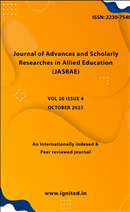Antibacterial potential of solid lipid nanoparticles containing anethi aetheroleum was investigated
Keywords:
Antibacterial, Potential, Solid Lipid, Nanoparticles, Anethi AetheroleumAbstract
The antimicrobial properties of Anethi Aetheroleum-containing solid lipid nanoparticles (SLNs) were investigated in this work. The powerful antibiotic Anethi Aetheroleum is derived from the essential oil of Anethum graveolens. As a result of their capacity to encapsulate bioactive chemicals more effectively and with greater stability, solid lipid nanoparticles are being considered as possible drug delivery vehicles. The primary objective of this research was to determine if SLNs containing Anethi Aetheroleum had any antibacterial effect on a set of pathogenic microorganisms. A modified emulsification-evaporation process was used to generate solid lipid nanoparticles loaded with Anethi Aetheroleum. The physicochemical characterization of the SLNs was done to evaluate their shape, zeta potential, and particle size. Common microbiological procedures for determining if SLNs generated have antibacterial activity include agar well diffusion and broth micro dilution. Researchers tested both pure Anethi Aetheroleum and SLNs loaded with the compound to see which one was more effective against germs. Conclusions SLN encapsulation of Anethi Aetheroleum improved stability and enabled controlled release. Furthermore, it was shown that SLNs had significantly more potent antibacterial activity compared to pure Anethi Aetheroleum. Strong antibacterial actions against Gram-positive and Gram-negative bacteria showed that the SLNs had a broad-spectrum effect.
References
Ling Z., Yonghong L., Junfeng L., Li Z., Xianqiang L. Tilmicosin- and florfenicol-loaded hydrogenated castor oil-solid lipid nanoparticles to pigs: Combined antibacterial activities and pharmacokinetics. J. Vet. Pharmacol. Ther. 2018;41:307–313. doi: 10.1111/jvp.12465.
Nations U. No Time to Wait: Securing the Future from Drug-Resistant Infections. WHO; Geneva, Switzerland: 2019. Report to the Secretary-General of the United Nations.
European Centre for Disease Prevention and Control Strategies and Action Plans on Antimicrobial Resistance. [(accessed on 21 April 2021)];
McKenna M. The antibiotic paradox: Why companies can’t afford to create life-saving drugs. Nature. 2020;584:338–341. doi: 10.1038/d41586-020-02418-x.
Qin S.Y., Zhang A.Q., Cheng S.X., Rong L., Zhang X.Z. Drug self-delivery systems for cancer therapy. Biomaterials. 2017;112:234–247. doi: 10.1016/j.biomaterials.2016.10.016.
Thakur S., Riyaz B., Patil A., Kaur A., Kapoor B., Mishra V. Novel drug delivery systems for NSAIDs in management of rheumatoid arthritis: An overview. Biomed. Pharmacother. 2018;106:1011–1023.
Akhtar A., Andleeb A., Waris T.S., Bazzar M., Moradi A.R., Awan N.R., Yar M. Neurodegenerative diseases and effective drug delivery: A review of challenges and novel therapeutics. J. Control. Release. 2021;330:1152–1167.
Blair J., Webber M., Baylay A., Ogbolu D., Piddock L. Molecular mechanisms of antibiotic resistance. Nat. Rev. Microbiol. 2015;13:42–51. doi: 10.1038/nrmicro3380.
Álvarez-Rodríguez I., Arana L., Ugarte-Uribe B., Gómez-Rubio E., Martín-Santamaría S., Garbisu C., Alkorta I. Type IV Coupling Proteins as Potential Targets to Control the Dissemination of Antibiotic Resistance. Front. Mol. Biosci. 2020;7:201. doi: 10.3389/fmolb.2020.00201.
Kamaruzzaman N.F., Kendall S., Good L. Targeting the hard to reach: Challenges and novel strategies in the treatment of intracellular bacterial infections. Br. J. Pharmacol. 2017;174:2225–2236. doi: 10.1111/bph.13664.
Hall C.W., Mah T.F. Molecular mechanisms of biofilm-based antibiotic resistance and tolerance in pathogenic bacteria. FEMS Microbiol. Rev. 2017;41:276–301. doi: 10.1093/femsre/fux010.
Diab R., Khameneh B., Joubert O., Duval R. Insights in Nanoparticle-Bacterium Interactions: New Frontiers to Bypass Bacterial Resistance to Antibiotics. Curr. Pharm. Des. 2015;21:4095–4105. doi: 10.2174/138161282128150922175445.
Munita J.M., Arias C.A. Mechanisms of Antibiotic Resistance. Microbiol. Spectr. 2016;4 doi: 10.1128/microbiolspec.VMBF-0016-2015.
Cerezales M., Ocampo-Sosa A.A., Álvarez Montes L., Díaz Ríos C., Bustamante Z., Santos J., Martínez-Martínez L., Higgins P.G., Gallego L. High Prevalence of Extensively Drug-resistant Acinetobacter baumannii at a Children Hospital in Bolivia. Pediatr. Infect. Dis. J. 2018;37:1118–1123. doi: 10.1097/INF.0000000000001962.
Cerezales M., Xanthopoulou K., Wille J., Krut O., Seifert H., Gallego L., Higgins P.G. Mobile Genetic Elements Harboring Antibiotic Resistance Determinants in. Front. Microbiol. 2020;11:919. doi: 10.3389/fmicb.2020.00919.
Águila-Arcos S., Ding S., Aloria K., Arizmendi J.M., Fearnley I.M., Walker J.E., Goñi F.M., Alkorta I. A Commensal Strain of Staphylococcus epidermidis Overexpresses Membrane Proteins Associated with Pathogenesis When Grown in Biofilms. J. Membr. Biol. 2015;248:431–442. doi: 10.1007/s00232-015-9801-1.
Kirtane A.R., Verma M., Karandikar P., Furin J., Langer R., Traverso G. Nanotechnology approaches for global infectious diseases. Nat. Nanotechnol. 2021 doi: 10.1038/s41565-021-00866-8.
Lombardo D., Kiselev M., Caccamo M. Smart Nanoparticles for Drug Delivery Application: Development of Versatile Nanocarrier Platforms in Biotechnology and Nanomedicine. J. Nanomater. 2019;2019 doi: 10.1155/2019/3702518.
Thorn C.R., Thomas N., Boyd B.J., Prestidge C.A. Nano-fats for bugs: The benefits of lipid nanoparticles for antimicrobial therapy. Drug Deliv. Transl. Res. 2021 doi: 10.1007/s13346-021-00921-w.
Bayón-Cordero L., Alkorta I., Arana L. Application of Solid Lipid Nanoparticles to Improve the Efficiency of Anticancer Drugs. Nanomaterials. 2019;9:474. doi: 10.3390/nano9030474.








